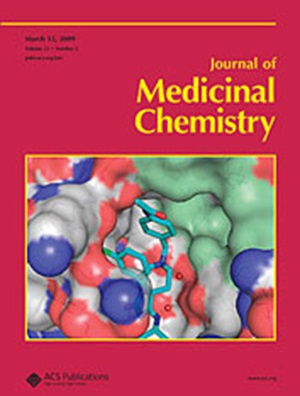Chemoproteomic Profiling of C. albicans for Characterization of Antifungal Kinase Inhibitors
IF 6.8
1区 医学
Q1 CHEMISTRY, MEDICINAL
引用次数: 0
Abstract
Candida albicans is a major cause of systemic candidiasis, a severe fungal infection with a ∼40% mortality rate. Yck2, a casein kinase 1 (CK1) in C. albicans, is targeted by antifungal inhibitors YK-I-02 (YK) and MN-I-157 (MN). Using multiplexed inhibitor beads and mass spectrometry (MIB/MS), the selectivity of these inhibitors was determined across the fungal kinome. The MIB matrix captured 89% of C. albicans protein kinases, revealing that YK and MN selectively engage three CK1 homologues (Yck2, Yck22, and Hrr25) and a human p38α homologue (Hog1). Chemoproteomics using a custom MN-kinobead confirmed the remarkable fungal kinome selectivity. To identify new Yck2 inhibitors with selectivity over Hog1, 13 human CK1 inhibitors were screened, leading to the discovery of a new chemotype with antifungal activity. These findings highlight the utility of MIB/MS in profiling nonhuman kinomes and developing selective fungal kinase inhibitors as antimicrobial agents.

白色念珠菌抗真菌激酶抑制剂的化学蛋白质组学分析
白色念珠菌是全身性念珠菌病的主要病因,是一种严重的真菌感染,死亡率约为40%。Yck2是白色念珠菌中的酪蛋白激酶1 (CK1),被抗真菌抑制剂YK- i -02 (YK)和MN- i -157 (MN)靶向。利用多路抑制剂珠和质谱(MIB/MS),确定了这些抑制剂在真菌激酶组中的选择性。MIB基质捕获了89%的白色念珠菌蛋白激酶,揭示了YK和MN选择性地参与了三个CK1同源物(Yck2, Yck22和Hrr25)和一个人类p38α同源物(Hog1)。使用定制的mn - kinobad的化学蛋白质组学证实了显著的真菌激酶选择性。为了鉴定对Hog1具有选择性的新的Yck2抑制剂,筛选了13种人类CK1抑制剂,从而发现了一种具有抗真菌活性的新化学型。这些发现突出了MIB/MS在分析非人类激酶和开发选择性真菌激酶抑制剂作为抗菌剂方面的实用性。
本文章由计算机程序翻译,如有差异,请以英文原文为准。
求助全文
约1分钟内获得全文
求助全文
来源期刊

Journal of Medicinal Chemistry
医学-医药化学
CiteScore
4.00
自引率
11.00%
发文量
804
审稿时长
1.9 months
期刊介绍:
The Journal of Medicinal Chemistry is a prestigious biweekly peer-reviewed publication that focuses on the multifaceted field of medicinal chemistry. Since its inception in 1959 as the Journal of Medicinal and Pharmaceutical Chemistry, it has evolved to become a cornerstone in the dissemination of research findings related to the design, synthesis, and development of therapeutic agents.
The Journal of Medicinal Chemistry is recognized for its significant impact in the scientific community, as evidenced by its 2022 impact factor of 7.3. This metric reflects the journal's influence and the importance of its content in shaping the future of drug discovery and development. The journal serves as a vital resource for chemists, pharmacologists, and other researchers interested in the molecular mechanisms of drug action and the optimization of therapeutic compounds.
 求助内容:
求助内容: 应助结果提醒方式:
应助结果提醒方式:


